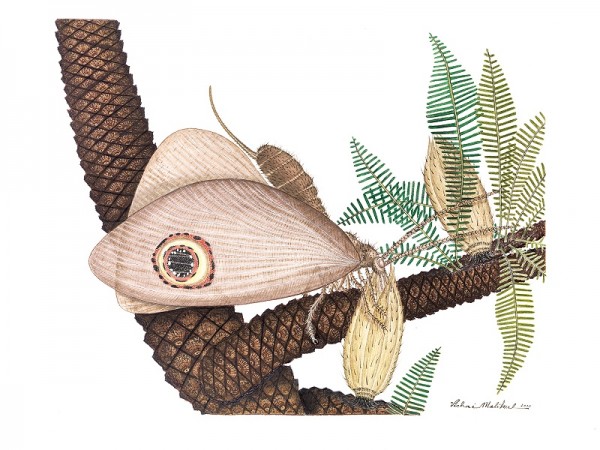By Ana Verayo, | February 05, 2016

An artist’s rendering of Oregramma illecebrosa consuming pollen drops from bennettitales, an extinct order of plant from the Triassic period.
Scientists have discovered an insect from the Jurassic period that looks like a butterfly, including its habits and behavior. However, this insect arrived 40 million years earlier than the butterfly, according to this new study.
Like Us on Facebook
The team has identified this new species which suggests convergent evolution where two animals that are distantly related to each other obtain remarkable similar characteristics as they evolve as a species separately.
Modern butterflies do not derive from this insect, where this Jurassic insect is actually an extinct "lacewing" from the genus kalligrammatid known as Oregramma illecebrosa. Today, a different genus still exists that include fishflies, owlflies, or snakeflies.
Researchers from Indiana University discovered this insect via well preserved fossils that are newly recovered from ancient lake deposits in Kazakhstan's eastern region and northeastern China.
According to author of the study, paleobotanist David Dilcher from the Indiana University, lacewing fossil evidence are always poorly preserved, preventing attempts to carry out a detailed examination of the kalligrammatid's morphology and ecology. However, these new fossils reveal a surprising array of physical and ecological attributes that are similar to the fossils of modern butterflies, where the two shared a common ancestor some 320 million years ago.
When the team was studying about a certain fossilized plant, Dilcher linked the insect to this planet where both belong to the same ecosystem in the same area in China. This plant is known as the bennettitales which is an extinct kind of seed plant that first showed up some 250 million years ago during the Triassic period. The seed plant survived for 200 million years until the end of the Late Cretaceous Period.
Microscopic evidence revealed that the kalligrammatid apparently fed on these plants, as the pollen was discovered trapped inside the mouth of the insects where they utilize their long tongues to scoop out the nectar found within the plant. Using their hairy legs, the insect also transferred pollen to the male and female reproductive parts of the plant to promote pollination.
This early evidence of pollination is also a crucial finding when it comes to the system of insect pollination among modern flowers and plants, where this early pollination promote reproduction with the use of a protective seed.
Scientists also note that the "eye spot" pattern on the wings of this insect is nearly identical as the modern owl butterfly, where this is used to ward off larger predators, making them appear bigger than they actually are.
This new study is published in the Proceedings of the Royal Society B.
-
Use of Coronavirus Pandemic Drones Raises Privacy Concerns: Drones Spread Fear, Local Officials Say

-
Coronavirus Hampers The Delivery Of Lockheed Martin F-35 Stealth Fighters For 2020

-
Instagram Speeds Up Plans to Add Account Memorialization Feature Due to COVID-19 Deaths

-
NASA: Perseverance Plans to Bring 'Mars Rock' to Earth in 2031

-
600 Dead And 3,000 In The Hospital as Iranians Believed Drinking High-Concentrations of Alcohol Can Cure The Coronavirus

-
600 Dead And 3,000 In The Hospital as Iranians Believed Drinking High-Concentrations of Alcohol Can Cure The Coronavirus

-
COVID-19: Doctors, Nurses Use Virtual Reality to Learn New Skills in Treating Coronavirus Patients







